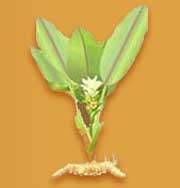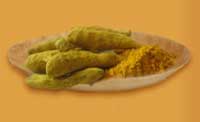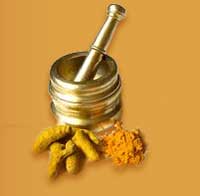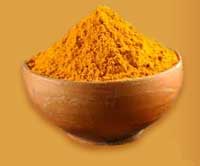TURMERIC
Introduction
Turmeric known as Curcuma longa is a native to Asia and India. The tuberous rhizomes or underground stems of turmeric have been used from antiquity as condiments, a dye and as an aromatic stimulant in several medicines.Turmeric is a very important spice in India, which produces nearly the whole world's crop and consumes 80% of its produce. India is by far the largest producer and exporter of turmeric in the world. Turmeric occupies about 6% of the total area under spices and condiments in India. Turmeric is the boiled, dried out, unsoiled and refined rhizomes of Curcuma longa. The plant is herbaceous permanent, 60-90 cm in height, with a petite stem and tufted leaves. There are 7 to 12 leaves, the leaf cover forms the simulated stem.
The lamina is green on top and pale green underneath and has a length of 30-40 cm and width 8-12 cm. Inflorescence is a middle spike of 10-15 cm long. 1-4 flowers are grown in Axil of the bract cavity one at a time. About 30 flowers are formed in a spike. Seeds are formed in capsules and there will be one to abundant hollow capsules in an inflorescence.
Common Names

History
Turmeric is local to Indonesia and southern India, where it has been produced for more than 5,000 years. It has played a significant role in many established cultures all through the East, including being a respected member of the Ayurvedic system. While Arab traders established it into Europe in the 13th century, it has only lately become accepted in Western society. Much of its recent fame is due to the latest study that has highlighted its therapeutic characteristics. The foremost marketable producers of turmeric includes developing nations like India, Indonesia, China, the Philippines, Taiwan, Haiti and Jamaica.
Uses
Cooking

Turmeric is added at greater levels to sausages, pickles, relishes, sauces, dry mixes, and fish due to its unique convention as a spice. Turmeric's color characteristics are endless but flavor and aroma are lost quickly if not stored appropriately. It should be stored in sealed containers away from sunlight. It is a key ingredient in curry powder and is often witnessed heavily in Asian cuisines. Because it imparts a vibrant yellow color to the food it is cooked with, it is frequently used to color as well as flavor condiments, rice dishes and sauces.
Medicine

This enhances the body's capability to digest fats. For continual digestive failing and congestion turmeric is suggested. It can be used as a single extract or in the type of digestive bitters, which combines turmeric with additional bitter and carminative herbs. Turmeric is useful for people who feel tired after consuming meals or for those who experience gas and bloating. Whatever way turmeric is eaten, it is advantageous to both the digestive system and the liver. Turmeric is valuable for its power on the liver. In spring more intake of herbs and foods can reinforce the liver. Turmeric shares comparable liver protectant compounds that milk and artichoke leaves hold. It is also widely used in the field of ayurvedic medication.
Cosmetics

These comprise home remedies for skin and hair troubles. Usual home cleansers like milk with turmeric powder are efficient natural cosmetics in themselves, it fetches a strong glow to the skin and makes them gorgeous. They also help to renovate or preserve youth by scheming wrinkles and crease creation on the surface of the skin. Turmeric can also cure unhealthy skin conditions including eczema, psoriasis and acne.
Turmeric Cultivation in India

